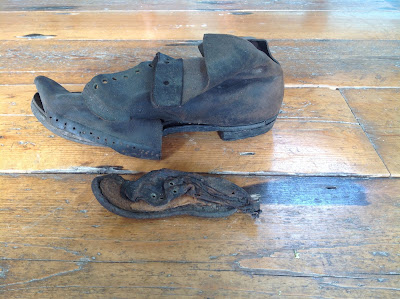No Place for Idle Hands-Part 1
Working life in Irish Workhouses
Life in Irish workhouses was not a straightforward case of
finding work for paupers and making sure they did it. This was because the
British Parliament had very set ideas about the employment of the poor.
A 1782 Act of Parliament stated that it was concerned with "the better relief and employment
of the poor". This shows that in the minds of politicians, relief and
employment went hand in hand.
If we fast forward to the 19th century we see that the concept
of employing the poor had evolved. As well as a general consensus that paupers should
be working within the workhouse walls, the instructions for pauper industry
have become more specific. In the British Isles this is most evident in the Irish
workhouse rules.
Paupers...shall
be kept employed according to their capacity & ability; but no
pauper shall work on his own account, or on account of any party other than the
Board of Guardians; & no pauper shall receive any compensation for his
labour.
It is interesting to note the use of the phrase "capacity & ability".
This shows that the British Poor Law Commission recognised that not everyone
could do the same amount of work, nor type of work. This phrase also meant that
it was possible for skilled labour, such as lace-making, to take place within
workhouse walls. However, skilled labour in Irish workhouses was to become a
contentious topic.
The Poor Law Commissioners in England had several abiding
worries. One was that workhouses would be seen as a provider of jobs. The last
thing that the Commissioners wanted was a situation where any unemployed person
could simply turn up at the workhouse and be handed a job.
The Boards of Guardians had a very different point of view.
They thought that workhouses could be run as self-sufficient enterprises rather
than institutions which were entirely funded by local rate-payers. In their
minds, a self-supporting enterprise would generate better conditions and future
prospects for paupers, as well as easing their own financial burdens.
The Guardians knew that entering the
workhouse was very shameful to Irish people. Some poor people were actually willing
to starve rather than enter the workhouse confines. And so it was very unlikely
that Irish paupers would ever consider using the workhouse as a convenient
source of employment.
The next biggest worry that Commissioners had was that
workhouse industry would impinge on local businesses. We know this from
correspondence between Boards of Guardians and the Poor Law Commissioners. However,
neither the Guardians nor the press thought this was a valid concern as a
journalist writing for The Nation in 1853 stated:
...in no instance has the encouragement of
pauper industry been found to interfere with the legitimate privileges of the
independent tradesmen outside.
It is no surprise then to discover that some of the Boards of Guardians and even Poor Law Inspectors sought to modify the
Commissioners’ approach to industry in Irish workhouses.
So while many paupers did spend their days engaged in menial and repetitive activities, a certain number of inmates engaged in skilled labour, producing high quality goods. This is a hugely under researched area of Irish Workhouse history and is a special area of interest for the Irish Workhouse Museum. We would love to discover some of the items produced by pauper industry but as yet, no examples of workhouse made lace or hair nets have been discovered.
By Elizabeth Carter
We have all heard of the Great Exhibition in Hyde Park, 1851. This huge event was a showcase for Victorian industry. However, not a lot of people know that there was a Great Industrial Exhibition held in Dublin in 1853. It was the
largest event of its day to be held in Ireland, with over 1 million visitors.
Various Irish industries were showcased, including quite incredibly, products of workhouse
industry. One journalist was particularly impressed by the 'most creditable specimens of female skill in
the way of doyleys, laces, stockings, quilts' . He goes on to express his
dissatisfaction with the Poor Law Commissioners' attitude to skilled labour in
the workhouses by writing that the workhouse items
'speak
powerfully of the vast extent of ingenuity, enterprise and skill which the law
tries in vain to strangle.'
His views are clear; paupers
are destitute of systems to support themselves, not of skill, nor the will to
work. This message is particularly moving when we consider the high numbers of
children in the workhouse system. The journalist notes 'the beautiful fancy work', 'great
variety of knitted work' and 'clever
embroidery' all created by the nimble fingers of the workhouses' young
inmates.
So while many paupers did spend their days engaged in menial and repetitive activities, a certain number of inmates engaged in skilled labour, producing high quality goods. This is a hugely under researched area of Irish Workhouse history and is a special area of interest for the Irish Workhouse Museum. We would love to discover some of the items produced by pauper industry but as yet, no examples of workhouse made lace or hair nets have been discovered.
By Elizabeth Carter


Comments
Post a Comment